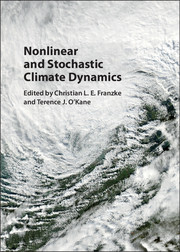Book contents
- Frontmatter
- Contents
- List of Figures
- List of Contributors
- Preface
- 1 Challenges for Ice Age Dynamics: A Dynamical Systems Perspective
- 2 Tipping Points in the Climate System
- 3 Atmospheric Teleconnection Patterns
- 4 Atmospheric Regimes: The Link between Weather and the Large-Scale Circulation
- 5 Low-Frequency Regime Transitions and Predictability of Regimes in a Barotropic Model
- 6 Complex Network Techniques for Climatological Data Analysis
- 7 On Inference and Validation of Causality Relations in Climate Teleconnections
- 8 Stochastic Climate Theory
- 9 Stochastic Subgrid Modelling for Geophysical and Three-Dimensional Turbulence
- 10 Model Error in Data Assimilation
- 11 Long-Term Memory in Climate: Detection, Extreme Events, and Significance of Trends
- 12 Fractional Stochastic Models for Heavy Tailed, and Long-Range Dependent, Fluctuations in Physical Systems
- 13 Modelling Spatial Extremes Using Max-Stable Processes
- 14 Extreme Value Analysis in Dynamical Systems: Two Case Studies
- Index
3 - Atmospheric Teleconnection Patterns
Published online by Cambridge University Press: 26 January 2017
- Frontmatter
- Contents
- List of Figures
- List of Contributors
- Preface
- 1 Challenges for Ice Age Dynamics: A Dynamical Systems Perspective
- 2 Tipping Points in the Climate System
- 3 Atmospheric Teleconnection Patterns
- 4 Atmospheric Regimes: The Link between Weather and the Large-Scale Circulation
- 5 Low-Frequency Regime Transitions and Predictability of Regimes in a Barotropic Model
- 6 Complex Network Techniques for Climatological Data Analysis
- 7 On Inference and Validation of Causality Relations in Climate Teleconnections
- 8 Stochastic Climate Theory
- 9 Stochastic Subgrid Modelling for Geophysical and Three-Dimensional Turbulence
- 10 Model Error in Data Assimilation
- 11 Long-Term Memory in Climate: Detection, Extreme Events, and Significance of Trends
- 12 Fractional Stochastic Models for Heavy Tailed, and Long-Range Dependent, Fluctuations in Physical Systems
- 13 Modelling Spatial Extremes Using Max-Stable Processes
- 14 Extreme Value Analysis in Dynamical Systems: Two Case Studies
- Index
Summary
Abstract
Teleconnections are spatial patterns in the atmosphere that link weather and climate anomalies over large distances across the globe. This chapter examines the spatial and temporal characteristics of teleconnections in both hemispheres, including the history of their discovery and research, and the methods by which teleconnections have been identified. We also present a detailed discussion on the leading theories of the physical mechanisms that account for the location, time scale, excitation, maintenance, and decay of teleconnections, as well as the role of tropical convection, and the inter-annual variability of teleconnections.
Introduction
It has long been recognized that the weather at one location on the Earth is linked to the weather at other very distant locations. These distances are often great, sometimes extending half way across the globe. The most striking example involves the atmospheric response to the so-called El Niño/Southern Oscillation (ENSO) phenomenon whereby changes in the sea surface temperature (SST) in the central equatorial Pacific Ocean are associated with massive changes in the weather all across the globe, from Peru to North America and to east Africa. Normally dry regions can experience intense flooding, and typically wet regions can experience extreme drought. The spatial patterns that characterize these remote linkages are referred to as teleconnection patterns. Teleconnections have the characteristics that they are persistent, lasting for 1 to 2 weeks, and often much longer, and they are recurrent, as similar patterns tend to occur repeatedly.
Discovery of atmospheric teleconnections dates as far back as the time of the Vikings. Amongst the earliest observers of atmospheric teleconnection were the Norse, or Vikings. The Norse first settled in Greenland in the year 985. In an anonymous Norwegian book entitled the “Kings Mirror”, approximately in the year 1235, in the context of a conversation between a father and his son, it was written that cold weather in Greenland coincides with warm weather at distant locations, and vice versa. Several centuries later, in the year 1785, the Danish missionary Hans Egede wrote ’In Greenland, all winters are severe, yet they are not alike.
- Type
- Chapter
- Information
- Nonlinear and Stochastic Climate Dynamics , pp. 54 - 104Publisher: Cambridge University PressPrint publication year: 2017
- 28
- Cited by



